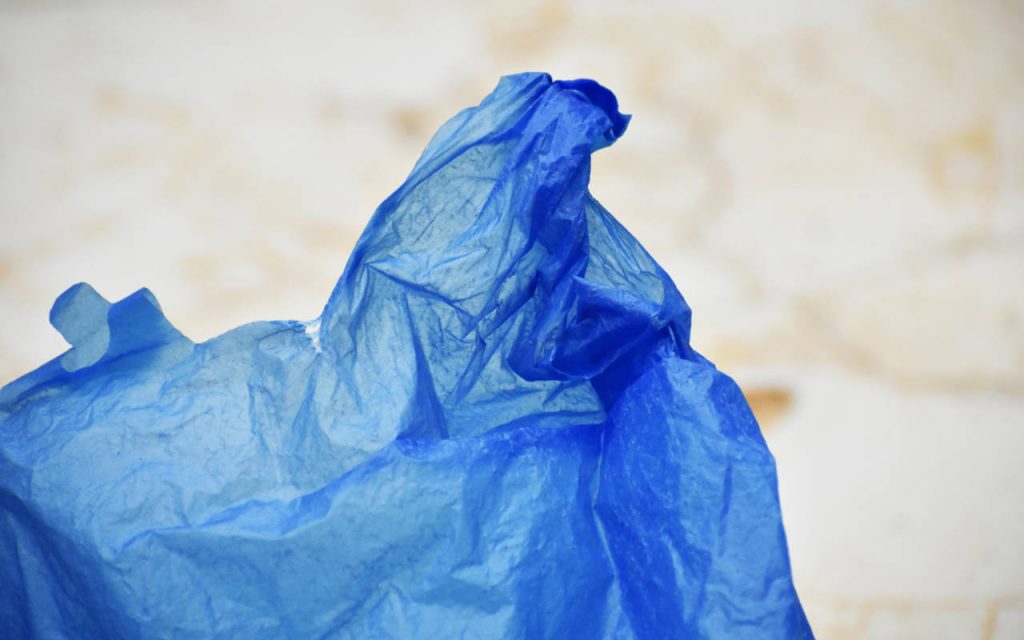Polythene bags are a super versatile packaging solution, not least because they can be blended with practically any colour you can think of! And one of the most common colour variants is blue polythene bags, which have a wide range of applications throughout the industries we serve.
Most people might associate blue polythene bags with the food industry – and they’d be right to. Blue isn’t very common in nature, with pretty much zero foodstuffs that are naturally blue. Even blueberries are closer to purple than blue – but we suppose “purpleberries” don’t sound quite as delicious… Anyway, that’s why chefs and kitchen staff wear blue plasters to cover cuts, and why blue polythene bags are used for industrial food production. Blue stands out very clearly in food, making it easier to spot contamination.
Besides food packaging and prep, blue polythene is highly important in the medical sector, in manufacturing, in construction and agriculture – and far beyond. Let’s look at blue polythene bags closer and why they’re so useful.

Blue is the colour of clean
Just like in food production, blue polythene is preferred in medical, dental and hospital settings because of how easily it can be identified. Besides the Blue Man Group, humans don’t have any blue body parts – so blue polythene stands out very clearly. This is super important in surgery, where plastic sheeting, PPE and packaging are needed. Making medical plastics blue means that, if they are accidentally introduced to someone’s body during surgery, they can be easily found.
Medical grade polythene is used for these applications. Blue polythene bags are also used in medical waste disposal, where colour coding is vital. In hospitals, blue waste bins are used for non-toxic medicines that have expired and need to be disposed of, and all blue waste is incinerated.
Learn more about Hazardous Waste Bags – Colour Codes And Uses
Because of this prevalence of blue in medical environments, we’ve come to associate it with cleanliness and sterility, and healthcare in general. It’s become a trustworthy and authoritative colour – and we’ll explore this aspect of blue a little more shortly.
Construction and agriculture
In construction and agriculture, blue polythene gets used for organising and containing debris, and protecting equipment from moisture and dust. Again – it’s super easy to see among other materials, and in agriculture, it makes contamination later down the line much less likely. This clear signalling is a common theme; blue is a prominent and elemental colour, but it’s hard to find on land. It stands out clearly, and it signals “this is important” in a way that red, green and yellow do not.
Clear signalling and manufacturing benefits
The distinct blue colour serves as a clear visual signal. This is really useful for indicating specific contents or uses – like hazardous waste bags. But it’s also a good way to eliminate confusion in busy work environments, where colour coding can speed up operations in manufacturing and on production lines.
By bagging like-for-like parts in coloured bags, and matching them into colour groups, workers (and machines) can quickly distinguish between the right components to use at each stage. And of course, blue polythene bags can be used in this process.
Blue branding
As we touched on earlier, the colour blue has come to hold deep meaning in branding. With such strong ties to medical and hospital environments, it’s seen as trustworthy and authoritative – but it’s also elemental; the colour of the sky and the ocean. It is powerful and out of reach. It has deep cultural meaning, because blue is so rarely found on land. Making blue things has historically been difficult – so through time, human culture has given blue an expensive and aspirational quality.
This is why so many big brands use blue in their logos and markings. It can significantly improve customer loyalty and trust, and studies have shown that people are 15% more likely to shop in stores painted in blue hues than warmer colours.
So, it makes sense to extend this to blue polythene bags in product branding strategies. Blue polythene bags can also be customised with printing: logos and slogans included. They provide a unique packaging solution that stands out on shelves, attracting customers’ attention and reinforcing brand identity.
They can also reduce costs by eliminating the need for multiformat packaging, instruction leaflets and separately printed regulatory wording. This is all good news, but are there any negatives to using blue polythene bags?
What are the disadvantages of blue polythene bags?
While there are so many benefits of blue polythene bags, we do have to consider the environment. Being blue, any blue polythene bags that reach the ocean may be harder to see, causing harm to marine life that becomes trapped in it or swallows it by mistake.
Opting for recyclable polythene is of course helpful, but not always possible (especially in medical applications) – which means that safe and ethical disposal is vital to keeping plastic – blue or otherwise – out of our oceans.
Custom blended blue polythene bags
NPF Packaging creates your ideal packaging products – including blue polythene bags, made to spec. Get a quote now, or call us on 01773 820415 to start your order.


